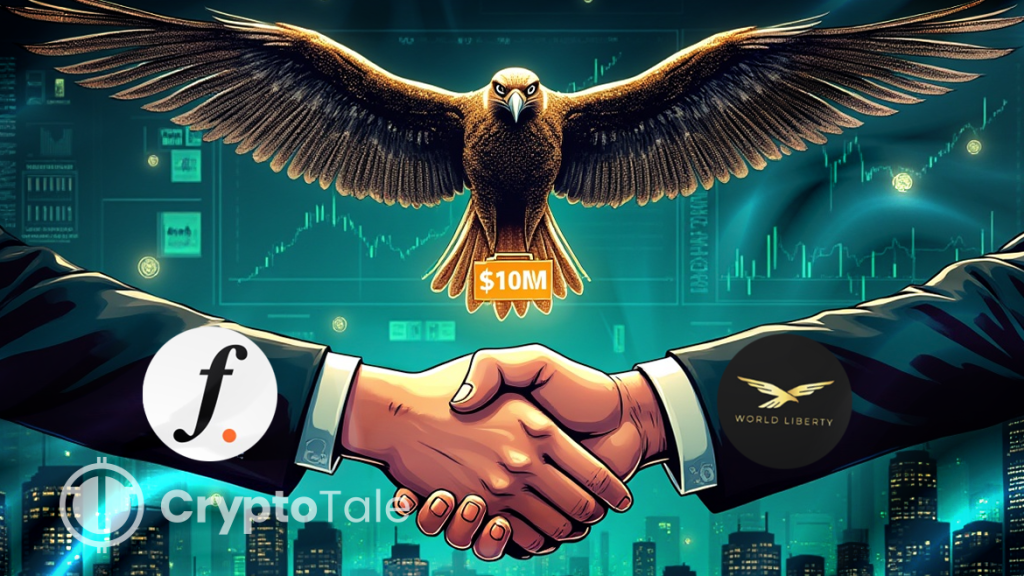Trump-Linked WLFI Invests $10M in Falcon Stablecoin Push

- Falcon Finance raised $10M from WLFI to boost USDf and USD1 stablecoin integration.
- USD1 is now used as collateral within Falcon’s risk-adjusted stablecoin protocol.
- DWF Labs’ earlier $25M WLFI token buy deepens links between the two DeFi platforms.
Falcon Finance has announced a $10 million strategic investment from World Liberty Financial (WLFI), a decentralized finance platform linked to the USD1 stablecoin. The financing will improve technical integrations, enabling interoperability between Falcon’s USDf and WLFI’s USD1 stablecoin.
According to the announcement, the partnership will support smart contract modules, shared liquidity provisioning, and seamless cross-chain conversions. The investment comes shortly after Falcon surpassed $1 billion in circulating USDf supply, a milestone achieved within months of its public launch.
Falcon Finance is developing a synthetic dollar stablecoin, USDf, with a dynamic overcollateralization model that will accept a wide variety of collateral. Conversely, the USD1 issued by WLFI is fiat-backed and can be redeemed at 1:1 to U.S. dollars. These two stablecoin models are likely to complement each other, with more flexible options available to the institutional and retail users across DeFi protocols.
Andrei Grachev, Managing Partner at Falcon Finance, said the partnership affirms the project’s approach to digital dollar infrastructure. “WLFI’s network will accelerate adoption and strengthen our ability to serve the growing demand for efficient on-chain dollar instruments,” Grachev noted in a press statement.
USD1 Integration Strengthens Falcon’s Collateral System
One key goal of the collaboration is to introduce USD1 as a collateral channel into the Falcon ecosystem. This evolution has the potential to improve the risk profile of the USDf system by adding a fiat-backed asset to its synthetic protocol.
Zak Folkman, the co-founder of World Liberty Financial, has stressed the advantages of this alignment. “By combining Falcon’s innovative collateralization model with our fiat-backed design, we are building a more resilient and flexible digital dollar ecosystem,” Folkman stated.
Falcon Finance’s infrastructure will bridge capital, collateral, and liquidity between the on-chain and off-chain environments. The platform enables users to convert their assets, such as fiat-pegged and yield-bearing tokens, into marketable liquidity. Its modular architecture can accommodate the implementation of an extensive number of financial applications and deployment strategies.
USD1, issued by WLFI, is backed by reserves such as U.S. Treasury money market funds and dollar deposits. Its current market capitalization of $2.17 billion adds a layer of transparency and safety to Falcon’s collateral structure.
Related: Stablecoin USDf Rebounds, Falcon Details Risk Strategy
Controversial Backers and Rapid Growth Raise Scrutiny
Falcon Finance is affiliated with DWF Labs, a crypto investment company with aggressive trading strategies and no regulatory licensing. The USDf stablecoin, launched in February 2025, is backed by DWF’s capital and operations.
DWF Labs’ co-founder, Andrei Grachev, is also the founder of Falcon Finance. Previously, Grachev worked at Huobi Russia, where he arranged exclusive trading deals. DWF Labs also participated in WLFI’s investment process, spending $25 million in a private transaction on the project’s governance token in April 2025. Falcon’s new funding indicates an extension of that investment approach, with a focus on reciprocal growth within the DeFi ecosystem.
Despite WLFI’s ties to the family network of U.S. President Donald Trump, the platform presents itself as an open and non-centralized platform provider. It aims to increase institutional engagement in DeFi by offering compliant and collateral-backed stablecoin products.
The post Trump-Linked WLFI Invests $10M in Falcon Stablecoin Push appeared first on Cryptotale
Disclaimer: The content of this article solely reflects the author's opinion and does not represent the platform in any capacity. This article is not intended to serve as a reference for making investment decisions.
You may also like
$8.8 billion outflow countdown: MSTR is becoming the abandoned child of global index funds
The final result will be revealed on January 15, 2026, and the market has already started to vote with its feet.

Deconstructing DAT: Beyond mNAV, How to Identify "Real vs. Fake HODLing"?
There is only one iron rule for investing in DAT: ignore premium bubbles and only invest in those with a genuine flywheel of continuously increasing "crypto per share."

Empowered by AI Avatars, How Does TwinX Create Immersive Interaction and a Value Closed Loop?
1. **Challenges in the Creator Economy**: Web2 content platforms suffer from issues such as opaque algorithms, non-transparent distribution, unclear commission rates, and high costs for fan migration, making it difficult for creators to control their own data and earnings. 2. **Integration of AI and Web3**: The development of AI technology, especially AI Avatar technology, combined with Web3's exploration of the creator economy, offers new solutions aimed at breaking the control of centralized platforms and reconstructing content production and value distribution. 3. **Positioning of the TwinX Platform**: TwinX is an AI-driven Web3 short video social platform that aims to reconstruct content, interaction, and value distribution through AI avatars, immersive interactions, and a decentralized value system, enabling creators to own their data and income. 4. **Core Features of TwinX**: These include AI avatar technology, which allows creators to generate a learnable, configurable, and sustainably operable "second persona", as well as a closed-loop commercialization pathway that integrates content creation, interaction, and monetization. 5. **Web3 Characteristics**: TwinX embodies the assetization and co-governance features of Web3. It utilizes blockchain to confirm and record interactive behaviors, turning user activities into traceable assets, and enables participants to engage in platform governance through tokens, thus integrating the creator economy with community governance.

Aster CEO explains in detail the vision of Aster privacy L1 chain, reshaping the decentralized trading experience
Aster is set to launch a privacy-focused Layer 1 (L1) public chain, along with detailed plans for token empowerment, global market expansion, and liquidity strategies.

